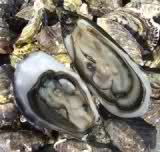 Oysters have been gathered from the wild for food long before scientific farming of the organism began. This bivalve is considered as one of man’s most nearly balanced natural food. It is a cheap source of protein and contains substantial quantities of all minerals and vitamins essential to the human diet. About 18% of the protein requirement, more than 50% of calcium and phosphorus, and all iodine and iron needed by an adult Filipino can be supplied by 200g of oyster meat. Aside from its edible portion, the shells of oysters are also used as raw materials for poultry and cattle feeds, fertilizers, pharmaceuticals and concrete products. Moreover, these can be recycled as cultches for collecting seeds. Other minor by-products include novelty items and ornaments
Oysters have been gathered from the wild for food long before scientific farming of the organism began. This bivalve is considered as one of man’s most nearly balanced natural food. It is a cheap source of protein and contains substantial quantities of all minerals and vitamins essential to the human diet. About 18% of the protein requirement, more than 50% of calcium and phosphorus, and all iodine and iron needed by an adult Filipino can be supplied by 200g of oyster meat. Aside from its edible portion, the shells of oysters are also used as raw materials for poultry and cattle feeds, fertilizers, pharmaceuticals and concrete products. Moreover, these can be recycled as cultches for collecting seeds. Other minor by-products include novelty items and ornaments
Site Selection
During culture period the oyster suffer from high mortality due to freshwater run-off brought about by heavy precipitation, adverse weather condition and abundance of fouling organism that are sometimes observed on collectors even prior to attachment of spats. These are some of the risks in oyster farming and to avoid these problems. It is necessary to conduct proper site selection for oyster cultivation. In general, a viable oyster farming ground should have the following characteristics:
* Water depth should ne 1.5-2.5m for traditional and at least 5.0m for non-traditional culture methods.
* Water salinity level is about 17-20 ppt and water temperature from 27-32 °C for faster growth.
* The area is not subjected to excessive flooding/freshwater run-off, which causes as mortality
* The site must be protected from strong currents and big waves. There should however, be moderate current for good water exchange to prevent build-up of decaying materials
* The site must be non-shifting or soft and muddy bottom to minimize siltation
Oyster beds should be free from predators and other natural enemies (borers, starfishes, crabs, etc.)
* There should be adequate cheap materials for cultch bamboo and empty oyster shells for spat collection.
* Presence of indigenous species of spawners to ensure adequate seed supply
* Materials for the farm structures should be readily available in the area
Site should be accessible and near to market outlets.
Culture Techniques
Four methods of oyster culture are practiced in the Philippines; broadcast (sabong), stake (tulos), lattice and hanging (bitin, sampayan, horizontal, and tray) methods.
Broadcast (“sabog”) method. The broadcast method is the most simple and primitive method and it is adopted in areas with firm enough bottoms to support the collectors. Empty oyster shells, stones, logs and tin cans are scattered over the selected area where natural setting occurs. Oyster spats are grown to the commercial size on the collectors. The advantage of the method is the low investment required, whereas the major disadvantages are that it can be used only in coastal areas with firm bottoms and shallow waters, high mortalities due to silt and predation, and difficulty in harvesting.
Stake Method. The stake method is usually used in areas with relatively shallow waters and soft muddy bottoms. The main material used in this culture system is bamboo poles (5–9 cm in diameter), however other rigid poles such as split coconut trunks and tree branches are often used. The stakes are driven into the bottom in rows and spaced 0.5 m apart. The tip of the stake extends to the high water level, due to the fact that oysters can survive and grow in the intertidal zone. The bamboo poles provide a clear surface to which the oyster larvae settle after their pelagic phase. Culturists often increase the attachment surface by adding horizontal bamboo sections or by clipping empty oyster shells or other hard materials to the stakes.This culture method is commonly used in Binakayan in Cavite, Binloc in Dagupan, Binmaley in Pangasinan and in Abucay in Bataan. The main advantage of this method compared to the broadcast one is that spat mortality is greatly reduced, and growth rate and production per unit area are increased. The disadvantages are that predators such as crabs, starfish, and burrowing snails can easily crawl up the stake and reach the oysters, the high cost of bamboo poles if not locally available and the relatively short life-span of the poles (1–2 years).
Latice Method. In this method bamboo splits are used to construct a lattice which is held together with galvanized wire or monofilament nylon twine. The splits are spaced about 15–30 cm apart and usually one lattice unit comprises 10–16 splits, which can be easily handled by one operator. This structure can be positioned in a great variety of ways, either horizontally or vertically. In the fence style the lattice is stuck on the bottom or supported by bamboo poles. It can also be mounted on rocks or suspended in the water column when mounted on long bamboos or empty drums. The above method is popular due to a number of advantages: the lattice can be used alone or in groups; collection and fattening of oysters occur efficiently, and harvesting is simple.
Hanging Method. Another effective and practical practice is the hanging method. Empty oyster shells or coconut shells are used as collectors. These are strung together on a synthetic rope and held 10 cm apart by spacers, such as bamboo tubes or knots made on the twine. Often collector shells are not spaced during the spatting season but are restrung with spacers during the grow-out phase. Usually each collector measures from 1–2 m depending upon the depth of the water. Variations of the hanging method are being used in the Philippines. In the bitin or inhitin variation the collectors are fastened on a bamboo platform or fence with bamboo posts attached horizontally near the high-tide level. The collectors are spaced at regular intervals of 25–30 cm. In the sampayan or long-line variation four or more parallel lines, approximately 20 m long and 20 cm apart, are strung between two bamboo poles. The cultches are fixed at regular intervals on the above lines. In the tray method, bamboo trays are used to hold the collectors. Rafts made of 5–6 bamboo poles are also employed. The rafts are moored to the four corner posts with enough slack to allow the raft to float at different water levels. The hanging collectors are fastened 30–60 cm apart. During the harvesting process, the collectors are merely untied from the bamboo poles and hauled to a raft or small boat.
The advantages of the hanging method are many, such as the high productivity per unit area and no mortality from silt and crawling predators. Disadvantages include the cost of materials (rope, bamboo, etc.), and the requirement of floats, anchors and anchor lines if the raft system is used.
General Farm Management
Once decided on the farming method and when the oyster spats have settled on the collectors, maintenance of the farm is necessary and this consists of the following procedure:
* Transportation and thinning-out prevents overcrowding and enables more uniform growth so that the farmer will be able to estimate his harvestable crop
* Adding additional buoys whenever necessary. As oysters grow, ropes get heavier and additional buoys must be provided to keep the bamboo framework above water and prevent the ropes from sinking to bottom
* Protecting the oysters from predators and getting rid of parasites, pests and silt. These fouling organisms reduce yield by crowding or smothering newly settled spats and slow down the movement of water and transport of food. Predator like crabs, sea urchin, oyster drills should be inspected and removed by hand while sponges, annelids and barnacles are scrap-off with knife
* Replacement of pegs. The grow out rope should be inspected regularly to see if the pegs should be replaced. If necessary additional pegs may be provided to support the entire oyster clusters.
Harvesting
Oyster is harvested before the spawning period when they are about 2.5 to 3 inches long, meat is flat, full rounded, bulging and creamy in appearance and when they are very rich in glycogen, a growth period of 8-12 months. They are best gathered in the month of March, April and May or before spawning period. Oyster need to be cleansed (depurated) prior to marketing because they harbor a lot of disease-causing organism by transferring or hauling rafts in cleaner and deeper areas for natural washing. Oyster is depurated mechanically by submerging/soaking them in clean running water for at least a week before they are hauled, cut and sold. If oysters are to be stored for some time they keep best at a temperature of 1°C or 34°F.
Marketing
Oyster are sold with their shells, shucked or salted form like into “bagoong” or “guinamos”. The unshelled oyster is sold by “kaing” direct from the farm, and retail in the market.
Problems and Constraints
Poor sanitary quality and limited demand are probably the major reasons for the failure of oyster farming to expand rapidly. Due to the former constraint the Philippine oyster export market is practically non existent.
Other problems in this culture system range from fouling organisms (eg. ascidians and algae) to siltation. However, these constraints can be avoided by correct management and by the adoption of the suitable culture technique for a given area.
Sources: 1. bar.gov.ph/agfishtech/fish/oyster.asp. Sept 2009. 2. Regaspi, P.B. Mariculture Section. BFAR. 2. Ritchie, T.P. October 1975. Experimental Introduction of the Philippine Oyster Crassostrea Iredalei and Philippine Green Mussel Mytilus smaragdinus in Fiji. 8th Regional Technical Meeting On Fisheries. UNDP/FAO.
Do you like this money making business idea? then please consider subscribing to our RSS feed and have new articles sent directly to your inbox.




VERY INFORMATIVE AND INSPIRING PRESENTATION
very nice i thing this is awesome article.